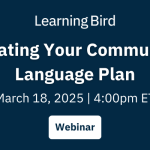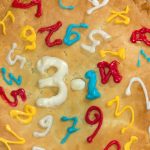Teaching Math in the 21st Century: Changing the Focus from Calculations to Critical Thinking
Math class can be a traumatic experience, and for whatever reason, people tie math closely to intelligence. Many people think you can do math if you’re smart, and if you’re not smart, you cannot.
According to statistics from the Carnegie Foundation, about half of all learners in the U.S. go to two-year colleges. Over half of those learners must take remedial math courses (often for no credit), essentially the same classes they took in high school. About 10% of those learners complete the remedial math courses, while the remaining 90% cannot and drop out of college.
Based on this data, what would you say is the top reason? Are there too many math standards? Do learners not have the ability? Are educators to blame? Is math not for everyone?
Rethinking How We Teach Math
I believe that neither math content nor learners are the problems, but rather the commonly taught method. Math involves logic, reasoning, critical thinking, and tenacity. These are all things that people love to do. Give a riddle to a person, and you will find that many people love trying to solve them. Sudoku puzzles enthrall people for hours. The same is true of board games, video games, etc. The human mind likes thinking, reasoning, and figuring things out. The main problem with mathematics is that it is not taught this way. It is not viewed as a riddle to be solved, and, oftentimes, math problems are not explained in a way that allows learners to thoroughly understand what they are looking for or why it is important. Math is shown as a series of steps to memorize and follow rather than understand and apply to new situations.
The skills needed for mathematics are real-world 21st-century skills that learners will need regardless of what they do with their lives. Many learners believe they “dislike” math because they will never need a particular algorithm or equation outside of school. That is true, but we will always need math courses focusing on reasoning and critical thinking skills.
So, if you were asked the best way to teach math, what would you say? A colleague asked me that very question. This post and video represent my response.
What a Good Math Teacher is Not
A good place to start might be to ask what a good math teacher is not.
Teacher ≠ Teller
Math teachers should not be math “tellers.” Rather than challenge learners to build their understanding of concepts, “tellers” tell learners how to understand.
You may be a math “teller” if you show learners how to solve a problem. Being a math “teller” is almost like giving learners a puzzle already completed rather than having the learners put it together themselves.
That brings up a fundamental issue with understanding what good teaching consists of. Most learners, parents, and even educators think you are a good teacher if you explain concepts clearly and concisely. What this means is that you are a good “teller.” The problem with telling is that learners are not challenged to think mathematically. In essence, the “teller” is doing all of the thinking for them. The learners are more focused on becoming good at calculations instead of discovery.
That is not to say that educators should not be helping learners, but helping learners is not the same thing as showing them how. This notion of educators “making things easier to understand” goes against what education research has shown us. Education research identifies one of the most important things educators do to affect learners’ conceptual understanding. That is to make sure learners are engaged in a productive struggle. It involves not simply telling learners how to make something easier but instead focusing on providing learners with challenges that contain clear instructions and enough time to figure things out. Educators’ biggest role is to promote 21st-century skills, create excitement, and build learners’ confidence in learning and thinking. None of this is promoted if educators are simply the medium in which learners get easier explanations.
Solving a Type of Problem ≠ Problem Solving
Another attribute a good math teacher does not have includes teaching learners exactly how to do a certain type of problem and then repeatedly giving them the same problem with different numbers. A simple computer can do this type of rote, basic skills learning. The last thing we need is learners thinking and acting like computers.
There needs to be a human element to learning. An aspect of discovering new concepts collaboratively, making mistakes, debating answers, attempting completely novel problems, etc., must be present. Doing calculations is not the same as doing math. Unfortunately, most assessments are simply assessing calculations while ignoring the concepts.
Math ≠ Race
One of my biggest gripes about tests like the ACT is that they are timed and more focused on calculations than actual thinking. Math (among other subjects the ACT assesses) is meant to be deeply thought about. Instead, learners learn how to take the test. This system gaming does not provide any in-depth thinking beyond the test itself. Assessments in math classes should not follow the ACT’s lead. It is much more beneficial to concentrate on problems than learners robotically completing problems as fast as possible to finish a test. If a concept is important enough to be tested on, then it is important enough to get the appropriate amount of time to be thought about.
Note: I am not saying that learners should be given as much time as they want on a test, but they should not feel rushed to finish a test. Showing mastery of a concept does not require a race against the clock.
As a society, we do not need speedy executors of processes anymore. Computers can do our calculations. We need mathematical modellers, predictors, justifiers, communicators, and problem solvers. We need more people who program and work with computers than people who act like them. These types of people are those who will take up future STEM jobs.
The heart of math is to deeply understand concepts and how they relate to solving other problems. This type of thinking is the basis of intelligence, and time should not limit this.
Math ≠ Memorizing Algorithms
With the ubiquity of information due to the advancements in technology, memorizing facts, formulas, and equations has become increasingly obsolete. Learners should spend valuable learning time working on higher-order thinking rather than rote memorization.
What Good Math Teaching Looks Like
Learning math can promote cognitive strengths that you cannot find in any other discipline. The kinds of thinking that I am talking about involve logic and reasoning. In this type of learning, numbers take a back seat to thinking.
However, such thinking is not part of most curricula. Instead, we get an unsteady collection of seemingly unconnected skills and procedures, which many educators proclaim to reteach every year as if the learners had never seen them before. Time and time again, research has shown that most learners who are considered to be “good at math” under the traditional math setting often cannot apply a single thing they have learned in a novel setting. As math teachers, we tend to focus on what to teach rather than how to teach. That makes math class more like a checklist of processes and algorithms for learners to memorize rather than mathematical thinking.
So what needs to change?
Inform Students How Learning Works
As discussed previously, an educator’s role is to inspire learners to think and want to think. In my opinion, too many learners think they hate math. In reality, they hate what they think is math. A better way of describing it might be “memorized mathematical procedures.” That makes sense if you know anything about control theory. People tend to focus more on what controls their learning than the learning itself. For example, rewarding learners with points or a grade for their learning tend to shift their focus to the points rather than the learning. I tell learners this on the first day. I explain the psychological ideas behind a lot of the teaching and how it can affect them. That way, learners have enough information to attempt learning in a different, more productive way that focuses on intrinsic motivation.
Provide Clear Instructions
Often, learners are not confused about mathematics. They are confused about the class’s setup, the lesson’s instructions, what they are trying to solve, and sometimes even how an educator’s website is arranged. The biggest confusion in class should be from the mathematics, not the learning environment. When giving learners a challenge, have them repeat the instructions you gave to ensure they understood.
Ditch the In-Class Lecture and Focus on Self-Paced, Collaborative Learning
Self-paced learning provides learners time to create their understanding of the material, while collaborative learning has been shown to increase understanding of concepts due to different perspectives.
Lecturing to an entire class assumes that all learners equally understand the content. It also does not provide a lot of opportunities for collaboration. Videos are a great alternative to lecturing and provide an excellent medium for learners to utilize self-paced learning. They can learn at their own pace, pause, re-watch, collaborate and ask more specific questions.
Learners should complete in-class challenges at their own pace. Often, concepts that they struggle with at the beginning make sense at the end of the course, allowing them to catch up to their peers. Also, mastering all units in a course except a few is much more valuable than understanding each partway.
Be Inspiring and Informative With Feedback
Some learners find math simple, while others find it difficult. However, this does not reflect their potential for future understanding. Learners have been gaining different experiences since childhood. Some of those experiences cause synapses to fire, and others do not. As educators, we need to change the path for learners who never had those synapses. Learners need an environment that is personally challenging. Neuroscience shows that every child can excel in math. The potential of the brain to grow is huge, and despite the belief in fixed math ability, every learning experience can change your math capabilities.
Educators should use fixed ability language as little as possible. That includes saying things like “You’re so smart,” “You’re so good at math,” “You struggle with math,” etc. While it may seem nice to give learners positive fixed ability comments, research shows that once learners do something that they perceive as not smart, they think what you said was incorrect. Instead, the focus should be on effort and actionable feedback. When giving feedback, please make sure learners know that you critique them because you believe in their ability and potential to succeed. Starting any feedback to a learner with a positive statement makes feedback even more powerful. Make sure to praise what learners have done rather than their intelligence.
Timely feedback as needed is best but difficult when educators lecture. Educators must be free to socialize with learners during class to give them retrospective feedback regarding past understanding and constitutive feedback related to future understanding.
As Grant Wiggins said, “Students need endless feedback more than they need endless teaching.”
Focus on Learners Actively Creating their Understanding Collaboratively
Simply put, if you don’t ask learners to think, they won’t.
How something works is vitally important, but the further applications of a concept become more extended when one understands the “why.” Most teachers face the problem that the “why” does not come immediately for most learners. Time is always against educators, and most classes are not self-paced. So, rather than spending time on understanding the “why,” educators give learners the easy way out by telling them what to do. The procedures are learned and then forgotten about easily and, since they were never fully understood, are never connected to new concepts.
That is why mathematics may seem fragmented instead of a connected web of concepts. That is not to say that learners do not need to know how to do basic skills. Instead of telling the learners, I recommend discovering it on their own through activities and problem-solving exercises. Having learners use past understanding of concepts to help them solve new problems helps tie old concepts to the new. That provides a deeper understanding for the learners. It is important to note that not all learners can discover concepts independently. That is where the educator comes into play. By providing hints, you urge learners to understand concepts by challenging themselves at their own pace.
As research shows, learners who participate in informal quantitative reasoning can complete formal math assessments with much greater ease. Similarly, learners who are asked to give reasons for their thinking are better at using logic to explain arguments.
Research has shown that when math focuses on problem-solving skills, logical reasoning, multiple forms of representation of concepts, and question formulation, learners perform at higher levels, take more advanced math courses, and create equitable achievement. When educators promote these aspects of math in class, rather than repeating procedures, learners’ intelligence and ideas are more valued, which leads to higher confidence in math. Furthermore, the main skills that math focuses on are reasoning and justification.
Differentiate
Confidence is a huge factor for doing well in math. Learners need to be completing problems at their level and finding success. When helping individual learners, try not to have predetermined questions. Instead, think about learners’ current understanding, listen to their ideas, and create interesting questions that relate directly to their ideas to push the limit of their understanding.
Avoid routines in questioning and the construction of problems. If you want learners to think outside of the box, you must challenge them accordingly.
Each learner is different, and to help all of them, educators need more passion and patience. Although these help, there need to be well-thought-out strategies for each learner. Educators must consider learners’ prior knowledge, confidence level, and motivation.
Make Sure Learners are Making Mistakes (while learning, not on summative assessments)
Recent brain evidence shows the value of learners working on challenging work and making mistakes. However, many learners are afraid of mistakes and think they are not math people. If mistakes are designed into the learning process rather than the grading process, learners will look to them as a way of learning rather than assessing their abilities. Research shows that mistakes cause more synapses in the brain and more growth.
Provide a Collaborative Work Environment
Feedback also needs to come from multiple sources, including peers, educators, experts online, and most importantly, self. Peer-to-peer feedback has been shown to increase learner understanding in both the learner giving feedback and the learner receiving feedback. Also, collaborative work environments provide for more detail in work produced and expected. Furthermore, collaborative work environments promote the usage of the 21st-century skill of communication.
How Do We Get There?
Don’t Think All or Nothing
Don’t think you have to change an entire course to match the math teaching style described. Chances are you already do a lot of what I described. If you make small changes and add more and more throughout the years, you will have a course that focuses on mathematical best practices. You can choose to modify a unit in a year or maybe one lesson a week. Like learning, teaching in new ways requires self-paced timing for educators. The comfort level and learning curve for teaching the prescribed way are different for each educator.
Have Backup
Make sure you have a support system in place to help you. I’m lucky enough to have an administrator that supports the way I teach and allows me to come to him if I ever need any help or ideas. Other educators (even in other subjects) can also be a great source of support.
Make Mistakes!
Don’t be afraid to make mistakes. Often educators avoid the possibility of making any mistakes not to create an ego disturbance. They view themselves in a certain way and do not want to try something new that would cause this view to be altered. As professionals, we must get over such discomforts for the sake of our learners.
Conclusion
Teaching math this way is rewarding, exhausting, and completely necessary. The world is changing more now than it ever has. We need logical thinkers, creators, and modellers of abstract ideas and concepts. Mathematics provides an excellent way of promoting those skills. We, as educators, need to make sure we teach it that way.
References
Hiebert, J., & Grouws, D. “The effects of classroom mathematics teaching on students’ learning.” N.p., 2016. Web. 21 Feb. 2016.
Bay-Williams, J. “Takeaways From Math Methods: How Will You Teach Effectively?” Edutopia. N.p., 2014. Web. 21 Feb. 2016. Cisco.com. (2016). Retrieved 22 February 2016, from https://www.cisco.com/c/dam/en_us/solutions/industries/docs/education/Multimodal-Learning-Through-Media.pdf
YouTube. (2016). e-Learning Affordance 4a: Recursive Feedback. Retrieved 22 February 2016, from https://www.youtube.com/watch?v=3LOjul-kJyc
Achievingthedream.org. (2016). Retrieved 22 February 2016, from http://www.achievingthedream.org/sites/default/files/resources/PathwaysToImprovement_0.pdf
Sciencedirect.com. “Modelling Reality In Mathematics Classrooms: The Case Of Word Problems.” N.p., 2016. Web. 15 Feb. 2016.
Koretz, D. M., et al. “The Effects Of High-Stakes Testing On Achievement: Preliminary Findings About Generalization Across Tests.”. Eric.ed.gov. N. p., 1991. Web. 15 Feb. 2016.
Wolfram, C. (2016). Teaching kids real math with computers. Ted.com. Retrieved 28 February 2016, from https://www.ted.com/talks/conrad_wolfram_teaching_kids_real_math_with_computers
Moser, J. S., Schroder, H. S., Heeter, C., Moran, T. P., & Lee, Y. H. (2011). Mind Your Errors Evidence for a Neural Mechanism Linking Growth Mind-Set to Adaptive Posterror Adjustments. Psychological Science, 0956797611419520.
Dweck, C. (2006). Mindset: The new psychology of success. Random House.
Youcubed at Stanford University. (2016). When You Believe In Your Students They Do Better. Retrieved 28 February 2016, from https://www.youcubed.org/think-it-up/when-you-believe-in-your-students-they-do-better/
Xkcd.com. (2016). xkcd: Forgot Algebra. Retrieved 28 February 2016, from https://xkcd.com/1050/
Mangels, J. A., Butterfield, B., Lamb, J., Good, C., & Dweck, C. S. (2006). Why do beliefs about intelligence influence learning success? A social cognitive neuroscience model. Social cognitive and affective neuroscience, 1(2), 75-86.








